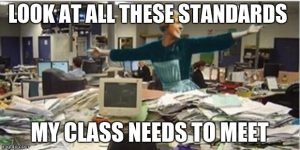Reading through Chapters 11 and 12 of Teaching Writing Online has made me realize how much my pedagogy already reflects many online teaching methods, even though I’ve not yet taught an online course. (It’s funny, this week, one of my student asked me to walk her through our Canvas site because she was still confused. Afterwards, she thanked me for helping her because “I haven’t taken an online class before.” The comment seemed bizarre to me, and she didn’t qualify it in any way. Reading the chapter helped me better understand what she meant, though. I take for granted a lot of the tools in my on-site classes that, really, are also suited for online teaching.)
Commenting through Canvas
Overall, my main form of assessment and feedback have been via Canvas’s built-in commenting functions (SpeedGrader, is it called?). I use the comment and highlighting aspects of it. Before I transitioned to Canvas last year, I used Blackboard’s similar function for a couple of years (whatever that one was called). Before that, I was handwriting comments on paper copies. I have found that I do end up putting a lot more feedback on the digital versions, mostly because I type faster and find it easier to think when I’m at a computer (oddly enough). I do think I have a tendency to overwhelm students, so would like to find new ways to approach commenting.
I also allow students to email me versions of their essay in advance for me to comment on, which somewhat minimizes my commenting on the final draft. I prefer, too, to get trough drafts digitally to office hours, which I feel is a bit taboo, but I think the feedback is better and that I don’t actually have to sacrifice a lot of the conversation.
However, I also try to build in a lot of assessment and feedback before essays are even submitted.
Assessing in Advance
Digital tools (and specifically Canvas, in this case) have been really useful to me when it comes to making sure students can assess their own writing without too much intervention from me (similar to what Warnock says: “good teachers can facilitate discussions onside or online that feature students prominently, but at times, students need your guiding hand” (125)). I’m a big fan of learning through example, which I’ve built into my classes by simply having students put their essay drafts on Canvas discussion boards. This allows them to explore in a way unanchored from hard draft peer review (and from peer review in general, which students often find a drag–though I still do it, since it allows me to also hold informal office hours during class time).
I’m skeptical of concepts of standards, because they are so top-down; using forums and discussions available digitally, however, create bottom-up “standards” that students can engage with. Students, then, absorb organizational structure, citing conventions, and other expectations simply by having a digital portfolio of student writing available to them. They see what is available to their writing, rather than being told (since the latter rarely ever works, at least for me).

Along with minimizing my own role as a figure of authority in favor to student-to-student learning, I also like Warnock’s idea of seeing my role as one of engaging in conversation than simply bestowing summative comments. I use digital tools to do this to some degree as well; I assign “reading responses” that are also posted on public discussion boards. These reading responses usually address aspects of the essay or attempt to develop skills relevant to the essay (without mentioning “the essay”); especially for about the first half of the semester, I respond at length to these posts, focusing on encouraging student ideas and avoiding too much “fixing” grammar or critiquing ideas. Many of the ideas ultimately end up in the essay and, therefore, I have already added my assessments in ahead of time. This is of course all possible in paper copies, but the conversation is then much less public and the record of the conversation disappears to quickly, for both me and my students.
This has also made me think of how I could use audiovisual means to further support this conversation, making it more of a “f2f” type of conversation rather than “textual” in the way Warnock describes (although, his definition of “text-based” is both fascinating to me and also a bit limiting). I am a little wary of audiovisual means of communication; they seem too performative and awkward to me, but if more natural conversations could be facilitated, I’d want to adopt more of those means (maybe through Skype or something like that, but overall I’ve mostly rejected tools like that. I have used Google hangouts when I worked at a graduate writing center, but it just felt so clunky and unnatural).
A lot of my strategies are, then, preemptive rather than tied to a particular moment of “assessment.”
In terms of reflecting a bit on the future (though the future is scattered throughout everything I’ve written already), I would like to figure out a way to use tools to better assess one of the more important aspects of student writing to me, close reading. Things like comments (whether voice, video, or traditional) and quizzes don’t seem to be particularly useful for getting students to really understand how to better close read. Often, when my students revise their essays, the close reading still remains lacking. This is one area I’m still at a loss to figure out, and Warnock doesn’t have many answer I like (comment banks and macros are rather frightening possibilities to me–they are so impersonal).
The theme in this post seems to be that I strive for a form of assessment that feels natural, decenters my authority, and is personal rather than mechanized.

Pingback: Cruising Utopia(n) Pedagogies | WritingwithMachines